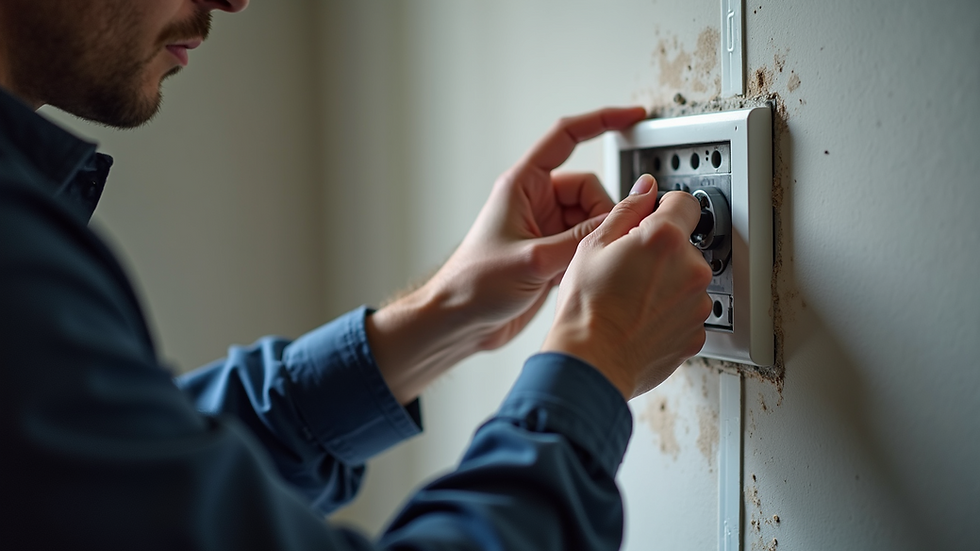How Routine Checks Keep Properties Safe and Compliant
- Bradley Hine

- Aug 21
- 4 min read
Maintaining a property is more than just keeping it clean and tidy. Regular inspections and safety checks are essential to ensure that buildings remain safe for occupants and compliant with legal standards. Routine property safety checks help identify potential hazards early, prevent costly repairs, and protect the wellbeing of everyone who uses the space. This article explores the importance of these checks, practical steps to implement them, and how they contribute to long-term property management success.
The Importance of Regular Property Safety Checks
Routine property safety checks are vital for several reasons. First, they help detect issues before they escalate into serious problems. For example, a small electrical fault can be identified and fixed before it causes a fire. Similarly, structural weaknesses can be spotted early, preventing accidents or costly damage.
Second, these checks ensure compliance with local laws and regulations. Property owners and managers have a legal responsibility to maintain safe environments. Failure to comply can result in fines, legal action, or even closure of the property.
Third, regular inspections provide peace of mind. Knowing that a property is safe and well-maintained builds trust with tenants, visitors, and employees. It also reduces liability risks and insurance costs.
To carry out effective property safety checks, it is important to have a clear schedule and checklist. This ensures that no critical areas are overlooked and that inspections are consistent.

How Property Safety Checks Protect Your Investment
Property safety checks are not just about compliance and safety; they also protect your financial investment. Properties that are well-maintained retain their value better and attract higher-quality tenants or buyers.
Here are some ways property safety checks protect your investment:
Preventing major repairs: Early detection of issues like leaks, cracks, or faulty wiring can save thousands in repair costs.
Reducing downtime: For commercial properties, safety checks minimize the risk of closures due to safety violations.
Enhancing reputation: Properties known for safety and upkeep attract more interest and command better rental or sale prices.
Lowering insurance premiums: Insurers often offer better rates for properties with documented safety checks.
A practical example is checking fire safety equipment such as smoke alarms and extinguishers. Ensuring these are functional can prevent fire damage and reduce insurance claims.

What are the 5 Steps in Health and Safety?
Understanding the key steps in health and safety management helps streamline property safety checks. The five essential steps are:
Identify hazards: Look for anything that could cause harm, such as slippery floors, exposed wires, or blocked exits.
Assess risks: Determine the likelihood and severity of harm from each hazard.
Control risks: Implement measures to eliminate or reduce risks, like fixing broken handrails or improving lighting.
Record findings: Document hazards, risk assessments, and control actions for accountability and future reference.
Review and update: Regularly revisit safety checks to ensure controls remain effective and adapt to any changes in the property.
Following these steps creates a systematic approach to maintaining a safe environment. It also helps demonstrate due diligence in case of inspections or incidents.

Practical Tips for Conducting Effective Property Safety Checks
To make the most of your property safety checks, consider these practical tips:
Create a detailed checklist: Include all critical areas such as electrical systems, fire safety, plumbing, structural integrity, and ventilation.
Schedule regular inspections: Depending on the property type, inspections might be monthly, quarterly, or annually.
Use qualified professionals: Some checks, like electrical or gas inspections, require certified experts.
Keep thorough records: Document every inspection, findings, and corrective actions taken.
Train staff and occupants: Educate everyone on safety procedures and encourage reporting of hazards.
Utilise technology: Use apps or software to track inspections and maintenance tasks efficiently.
By following these recommendations, property managers can ensure that safety checks are thorough, consistent, and effective.
The Role of Health and Safety Checks in Compliance
Maintaining compliance with health and safety regulations is a legal obligation for property owners and managers. Regular health and safety checks help meet these requirements by:
Ensuring fire safety equipment is up to date and functional.
Verifying that emergency exits are accessible and clearly marked.
Checking that electrical installations meet safety standards.
Confirming that gas appliances are serviced and safe.
Monitoring environmental hazards such as mould or asbestos.
Non-compliance can lead to penalties, legal claims, and damage to reputation. Routine checks demonstrate a proactive approach to safety and help avoid these risks.
Building a Culture of Safety Through Routine Checks
Beyond legal compliance and financial protection, routine property safety checks foster a culture of safety. When safety is prioritised, occupants feel more secure and valued. This can lead to:
Increased tenant satisfaction and retention.
Higher employee morale and productivity in workplaces.
Reduced accidents and related costs.
Better community relations and public image.
Encouraging everyone involved with the property to participate in safety efforts creates a shared responsibility. Simple actions like reporting hazards or following safety protocols contribute to a safer environment for all.
Routine property safety checks are a cornerstone of effective property management. They protect people, preserve assets, and ensure compliance with regulations. By implementing systematic inspections, documenting findings, and addressing issues promptly, property owners and managers can maintain safe, compliant, and valuable properties for years to come.



Comments